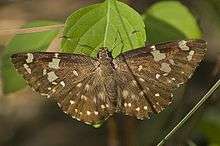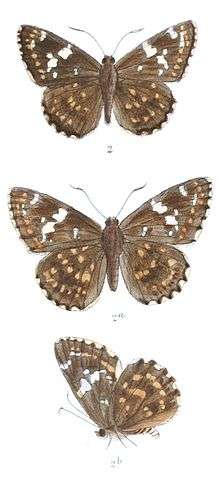Celaenorrhinus ambareesa
| Malabar spotted flat | |
|---|---|
| | |
| Scientific classification | |
| Kingdom: | Animalia |
| Phylum: | Arthropoda |
| Class: | Insecta |
| Order: | Lepidoptera |
| Family: | Hesperiidae |
| Genus: | Celaenorrhinus |
| Species: | C. ambareesa |
| Binomial name | |
| Celaenorrhinus ambareesa (Moore, 1865[1]) | |

Celaenorrhinus ambareesa,[2][3] the Malabar spotted flat,[4] is a butterfly of the hesperiid family found in Asia.
Range
The butterfly is found in India and ranges from South India to Khandesh, Madhya Pradesh to West Bengal.[2][4]
Description
Unlike the common spotted flat, the semi-transparent white spots on the upperside of the forewings are separated from each other. It also has distinct rows of pale yellow spots on the hindwing and the hairy fringe of the wings (cilia) is chequered with black and white. All the spotted flats have similar habits and habitats. The Malabar spotted flat is more likely to be found under boulders and logs overhanging forest streams.

In 1891 Edward Yerbury Watson described it as:
Upperside dark olive-brown, the whole surface irrorated with delicate yellowish-olive scales: forewing with an oblique transverse discal series of pale yellowish-white semi-transparent spots, the first large and within the extremity of the cell, being indented exteriorly, the second small and some distance beyond, the third large and beneath the latter; below the last are two other small spots; and one-third from the base beneath the cell is a small round similar spot; above the first on the costa is a small brighter yellow spot, which is not transparent; before the apex are five rather large similar spots, the three upper conjugated as are also the other two; one or two lower submarginal very indistinct orange-coloured spots: hindwing with a row of ill-defined orange-coloured submarginal spots, and others still less defined nearer the base: cilia of both wings broad, alternate brown and yellowish-white. Underside paler, more uniform in colour; markings as above.— Edward Yerbury Watson[5]
Wingspan: 45 to 55 mm.[4]
Distribution
This butterfly is commonly found in moist-deciduous, semi-evergreen and secondary evergreen forests with a dense herb and shrub layers. It is particularly frequent in places where openings in the canopy let sunlight fall on the ground vegetation.[6]
The butterfly is most commonly seen in the post monsoon season. The population is low in the winter and summer months but increases prior to the monsoon.[6]
Status
Not rare.[4]
Cited references
- ↑ Plesioneura ambareesa, Moore, P. Z. S., 1865:788.
- 1 2 Markku Savela's website on Lepidoptera Page on Celaenorrhinus genus., Subfamily Pyrginae, Family Hesperiidae
- ↑ Card for ambareesa in LepIndex. Accessed 22 September 2007.
- 1 2 3 4 Evans, W.H. (1932). The Identification of Indian Butterflies (2nd ed.). Mumbai, India: Bombay Natural History Society. p. 324, ser no I11.3.
- ↑ Watson, E. Y. (1891) Hesperiidae Indicae: being a reprint of descriptions of the Hesperiidae of India, Burma, and Ceylon.
- 1 2 Kunte, Krushnamegh (2000). Butterflies of Peninsular India. India, A Lifescape. Hyderabad, India: Universities Press. pp. 146–147, ser no 64. ISBN 978-8173713545.
See also
References
- Evans, W.H. (1932). The Identification of Indian Butterflies (2nd ed.). Mumbai, India: Bombay Natural History Society.
- Kunte, Krushnamegh (2000). Butterflies of Peninsular India. India, A Lifescape. Hyderabad, India: Universities Press. ISBN 978-8173713545.
Online
- "Markku Savela's website on Lepidoptera"..
- Beccaloni, George; Scoble, Malcolm; Kitching, Ian; Simonsen, Thomas; Robinson, Gaden; Pitkin, Brian; Hine, Adrian; Lyal, Chris. "The Global Lepidoptera Names Index (LepIndex)". Natural History Museum, London. Retrieved 2016-10-15.